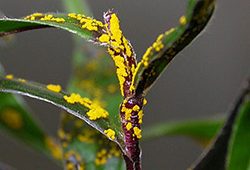
Since 2010 a strain of myrtle rust, a fungal disease native to South America, has firmly established in eastern Australia, threatening many native plant species in the myrtle rich forests along Australia’s east coast. Source: Timberbiz
Other strains, not yet in Australia, have decimated eucalypt plantations in South America.
Myrtle rust experts and state and commonwealth policy teams met in Canberra to review the threat of myrtle rust to native biodiversity and commence work on the development of a national action plan to guide research and on-ground acIons.
‘Myrtles’ refers to plants of the family Myrtaceae, Australia’s largest plant family, including many iconic Australian native trees and shrubs including eucalypts, tea-trees, bottlebrushes and paperbarks of great environmental, economic and cultural significance.
The wind-borne nature of the disease and the abundance of suitable plant hosts in the Australian environment has seen myrtle rust spread rapidly along the entire east Australian coastline and to the Northern Territory.
South Australia and Western Australia are maintaining stringent domestic quarantine to keep the disease out of those states.
Myrtle rust has also recently been found in New Zealand, prompting a major biosecurity response.
According to workshop co-organiser and Chair of the Myrtle Rust Environmental Impacts Working Group Mr Bob Makinson, myrtle rust (Austropuccinia psidii) has proved capable of infecting more than 380 native Myrtaceous species and is causing drastic decline in some species in the wild.
“About half of Australia’s 2250 species of Myrtaceae occur in areas likely to, or known to be, conductive to myrtle rust establishment.
“Our expectation and fear is that the number of species prone to infection will increase. It is very likely we will see some plants become extinct in the wild as a result of this pathogen. Up to about 50 species are of immediate concern, and we urgently need field surveys to determine how they are being impacted.
“Many of the species known to be highly susceptible are already listed as threatened under state or Commonwealth legislation, and others that used to be common are now in severe decline,” he said.
Dr Michael Robinson, CEO of the Plant Biosecurity CRC, believes national coordination of research and management for myrtle rust is critical.
“Through our research efforts with the NSW Department of Primary Industries and Queensland Department of Agriculture and Fisheries, we know that myrtle rust has the potential to have severe economic impacts on plant nurseries, native and plantation forestry and new growing industries such as lemon myrtle production.
“Impacts on the natural environment and biodiversity are equally concerning, but less understood. It is for this reason we need a concerted national approach to understand and manage this disease.
“Importantly it will help us establish processes and expertise to respond to other pathogens that may prove even more destructive should they enter Australia. This workshop is a critical step.”





